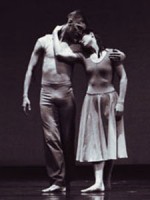Column Name
Title
Groundbreaking dance educator Martha Hill (1900-95) was responsible for founding and directing three degree-granting college dance programs or departments: at Bennington College (1932), New York University (the graduate degree in dance in 1938), and Juilliard (1951). She also launched two summer dance festivals: at Bennington in 1934 and the American Dance Festival at Connecticut College (now held at Duke University) in 1948.
Body
Elizabeth McPherson (B.F.A. ’90, dance) only had “Miss Hill” (as she was called by her legions of devoted students) for one course at Juilliard, Senior Seminar, but at Hill’s memorial service in 1995, McPherson was so moved and fascinated by the deeply meaningful relationships described by students of Hill’s earlier days that she decided to make her the subject of her doctoral thesis at N.Y.U., where she completed her Ph.D. in dance education in 2006. McPherson’s The Contributions of Martha Hill to American Dance and Dance Education, 1900-1995—expanded into book form and published last May by the Edwin Mellen Press—is the first in-depth study of Hill and the significance of her achievements. McPherson herself is an assistant professor of dance education at Montclair State University.
Hill said that she became a dancer “out of sheer orneriness,” because it was “not something that one did” as a girl from small-town Ohio in the first decades of the 20th century. What was dance education like on the college level when Hill first set out, and how did she manage to change it?
There were no dance departments when Hill was growing up, but a few dance courses were offered within physical education programs, often “aesthetic dancing,” which Hill described as simplified ballet with some folk and social dance. This was what Hill had mostly studied until she made her way to New York in 1926, happening to see Martha Graham’s second independent concert. It was a life-changing experience. She left New York for a teaching position at University of Oregon, but when she returned in 1929, she joined Graham’s company. Although with the company only two years, Hill took her performance experience with her into higher education, putting a strong emphasis on choreography and performance at each of the schools where she taught. She also brought in as teachers professionals such as Graham, Doris Humphrey, Charles Weidman, and José Limón. And at Juilliard, Hill and President William Schuman developed a curriculum of combined ballet and modern dance training, which was a brand-new idea.
What accounted for the enthusiasm and devotion of her students, evident everywhere she taught?
I think it starts with her incredible charisma. She was one of those people whose presence you feel in a room without necessarily even seeing the person. She also cared deeply about her students as dancers and as people. I think they felt that, and reciprocated. She called her students her children, and more than one sent her Mother’s Day cards.
While working on this project, what did you learn about Hill that most surprised you?
I knew that she was one of the great dance educators of the 20th century, but I had not fully realized the profound effect she had on the professional dance field. At Juilliard, not only did she have as students important dancers/choreographers such as Paul Taylor, Lar Lubovitch, Bruce Marks, Susan Marshall, and Martha Clarke, but through the institutions where she worked she also commissioned works from Graham, Humphrey, Limón, Hanya Holm, Antony Tudor, Anna Sokolow, and many others, allowing them freedom to create without the pressing worry of how to fund the creation.
Can you share one of your favorite stories about her?
Well, on my first day as a student at Juilliard, Hill ran a freshman orientation seminar. She told us never to set anything on a piano, and to always read the bulletin board, among other things. She also told us about the Dance Division’s trip to Hong Kong the previous June. She said that 100 white doves were set loose in their honor. A returning student who had been on the trip interrupted her to say that they weren’t doves, but pigeons! It made me laugh, but introduced me to Hill’s poetic and positive view of life.
Has writing this book shaped the way you teach?
Most definitely. I think about Hill as I work at getting to know my students beyond the classroom or studio. What are they interested in? What do they do outside of school? How does that affect what they do inside school? Hill came from a progressive, pedagogical background, and she was a real humanist, interested in the entirety of her students’ lives—as dancers, artists, and people. I find that inspirational.





